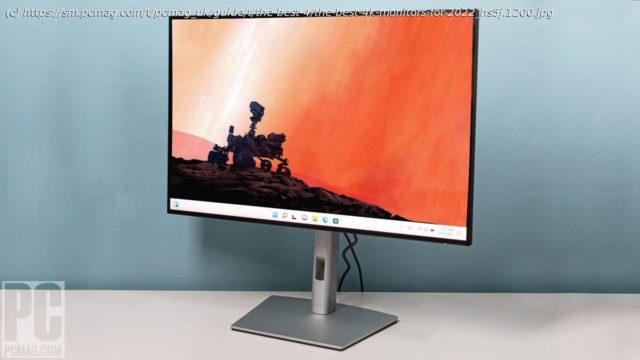Fast becoming mainstays of gamers and creative pros, 4K monitors are falling in price—but getting more complicated to buy. Here’s how to shop for an ultra-high-definition (UHD) display, plus our top picks from deep-dive reviews.
Whether it’s for gaming, office productivity, or creative work—or just to stream your favorite movies—a 4K monitor is a must-have upgrade for many PC users. But the 4K or ultra-high-definition (UHD) monitors on the market today are far from alike. Some offer speedy refresh rates to suit hardcore gamers. Others are designed for graphics pros, with precise color accuracy and support for wide color ranges. And some pack workflow-enhancing features that can make managing your desktop much easier.
Here’s everything you need to know about the benefits (and possible pitfalls) of getting a new 4K display today. We’ve also ranked the 4K monitors that have made the cut according to our detailed testing. They’re a great starter set for your search. They’re broken out below, followed by a detailed guide to buying a 4K panel.
Ready to buy a 4K monitor? Let’s define 4K first. The vast majority of 4K monitors have 16:9 aspect ratios with a native resolution of 3,840 by 2,160 pixels (horizontal by vertical). That’s four times as many as a full HD or 1,920-by-1,080-pixel panel—and that’s a lot of pixels. Some other resolutions with approximately 4,000 pixels across—most commonly 4,096 by 2,160—are also considered 4K. All these panels remain premium choices, but they’re becoming increasingly common on desks at work, at home, and in gamers’ frag dens.
But before we get too deep into details, we should help you answer a key question: Is a 4K monitor right for you in the first place? Depending on what you do most with your monitor, and where you’ll place it, the extra money you’d pay versus a lower-resolution display may not be necessary.To 4K or Not to 4K: That’s the Gamer’s Dilemma
For starters, if you want a really big 4K monitor solely for home-entertainment purposes that don’t center on PC gaming, a 4K TV would likely be a cheaper option. That’s because many 4K TV sets aren’t beholden to the same standards that 4K monitors are, such as the need for boosted refresh rates (for gaming models), elite or specialized color accuracy (for content creators), or low input lag. (See our picks for the best TVs, now uniformly 4K models.)
Let’s take gaming. While gorgeous to look at, playing modern games at 4K resolution takes a ton of graphics horsepower to get above 60 frames per second (fps), today’s generally acknowledged minimum for serious gamers. Right now, only a handful of high-end graphics cards can reliably drive a 4K display with leading game titles at top image-quality settings. (And if you’re turning down the detail settings to make a game run better at 4K, that defeats much of the point of 4K in the first place.)
These elite cards include models like Nvidia’s GeForce RTX 3080, GeForce RTX 3090, and GeForce RTX 2080, as well as AMD’s Radeon RX 6800 and RX 6700 series—all commanding steep prices. If you don’t have such a card, gaming at 4K is going to demand compromises and may not be worth the splurge.
Gaming at 4K resolution isn’t strictly about your hardware nowadays. A crop of software technologies (image sharpeners, upscalers, and supersamplers) from both AMD and Nvidia have hit the market recently. In a nutshell, these aim to allow PCs with midrange graphics cards or lesser integrated graphics (and gaming-console GPUs) to run at higher resolution while minimizing the performance hit and loss in visual quality. While they may not be true 4K gaming, to my eyes and many more they’re the best that console and mid-budget gamers can do until hardware prices come down again.
The details of software enhancement and supported platforms and games for both Nvidia and AMD can and have already deserved their own articles, so we won’t slow down to go over the nuances here. But if one of these scenarios fits your needs, the next step is to figure out whether a 4K monitor is right for you for different reasons: your desk configuration and your eyesight.Next Question: Can You See in 4K?
When shopping in the HDTV aisle, the answer as to whether you should opt for a 4K model today is almost always yes, because it’s hard to find TVs with other resolutions these days. It’s not quite as simple with 4K monitors. Getting serious about the question comes down to algebra and raises issues like pixel pitch, pixels per inch (ppi), and something called angular resolutions. Let’s try to keep it simple, however.
A good example of the pixel-pitch problem arises with virtual reality (VR) headsets and an issue known as the screen door effect. In essence, the lower a display’s maximum resolution and the closer you sit to it, the easier it is to see its individual pixels. In the case of VR headsets, this can make the image look as if it’s seen through mesh, and it’s why headset resolution has grown steadily—when something’s that close to your eyes, you can more clearly see the difference.
The same considerations apply to monitors, just across a viewing distance measured in feet instead of inches. The tricky bit is that viewing distance isn’t fixed but depends on the size and layout of your desk, your chair position, and so on. Whether you can make out the difference in image quality between a 4K display and, say, a 1440p panel (2,560 by 1,440 pixels) depends on not only the distance but your eyesight and the screen size. The last calculates out to a certain number of pixels per inch, in essence the screen’s pixel density. You can see how it scales here at each common resolution.
Luckily, we don’t have to the math on our own. Workstation vendor Puget Systems has designed a helpful Google Sheet that will automatically help you figure the optimal display size and resolution for you depending on your personal visual acuity. All you have to do is plug in your target screen size and resolution, the distance between your eyes and the screen, and the specifics of your eyesight. You can then try different numbers and see how the output changes, helping you figure out if a certain size or distance makes more or less sense. (If you haven’t been to the eye doctor lately and don’t know your prescription strength, a few more calculations using some of the formulas on this page are all you need.)
Of course, less scientifically, you can look at 4K panels of various sizes in a local store to see if you can tell the difference between them and similarly sized 1440p or 1080p monitors.






